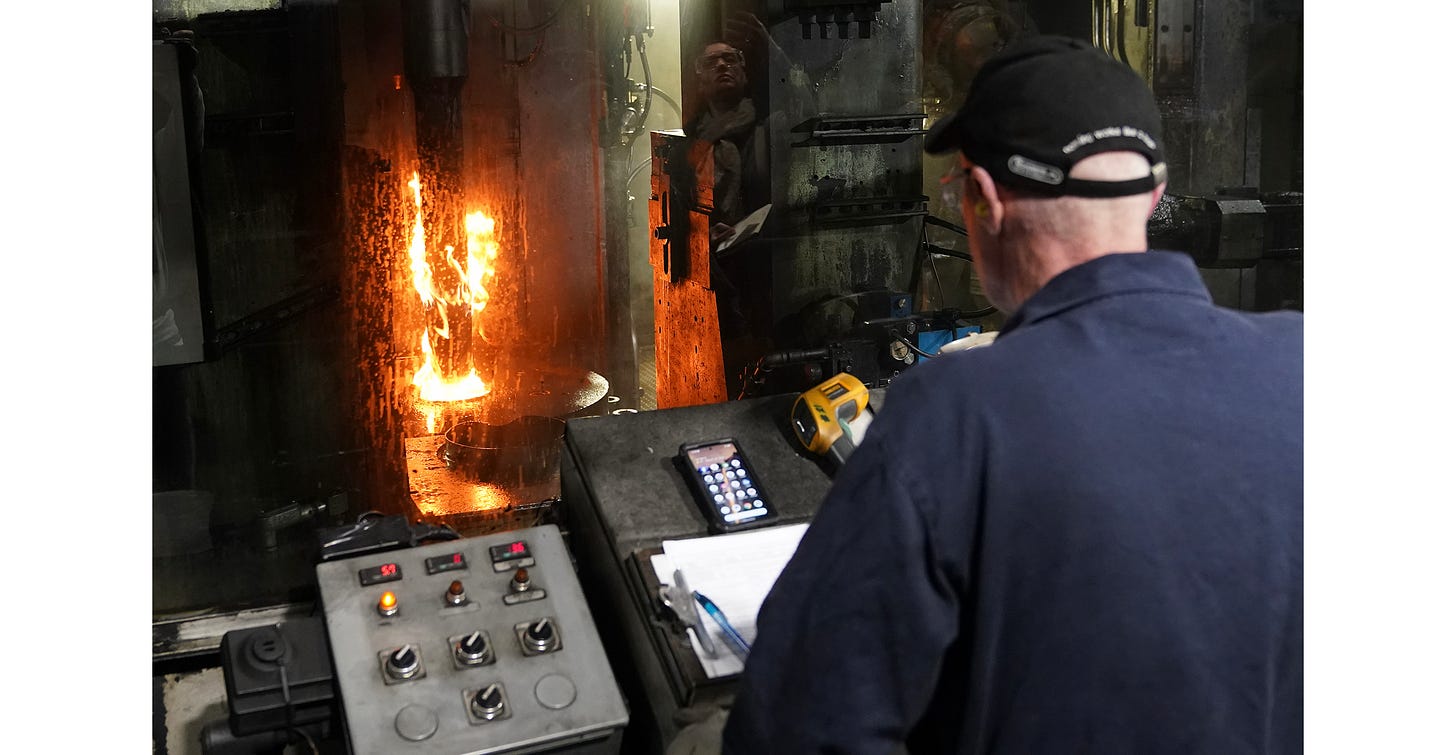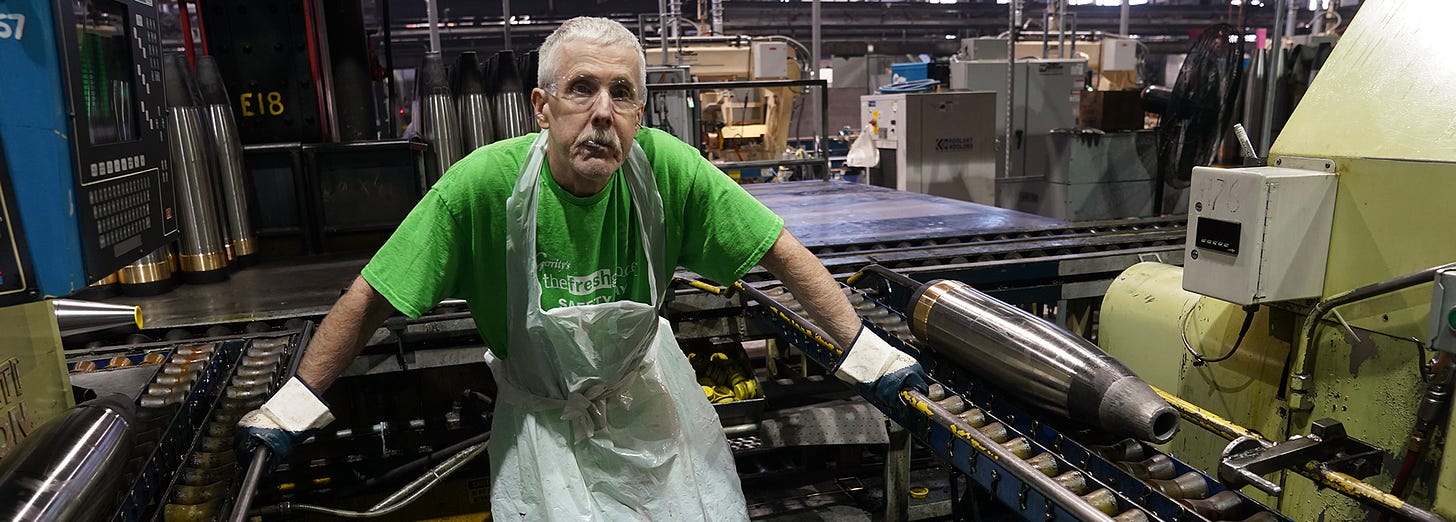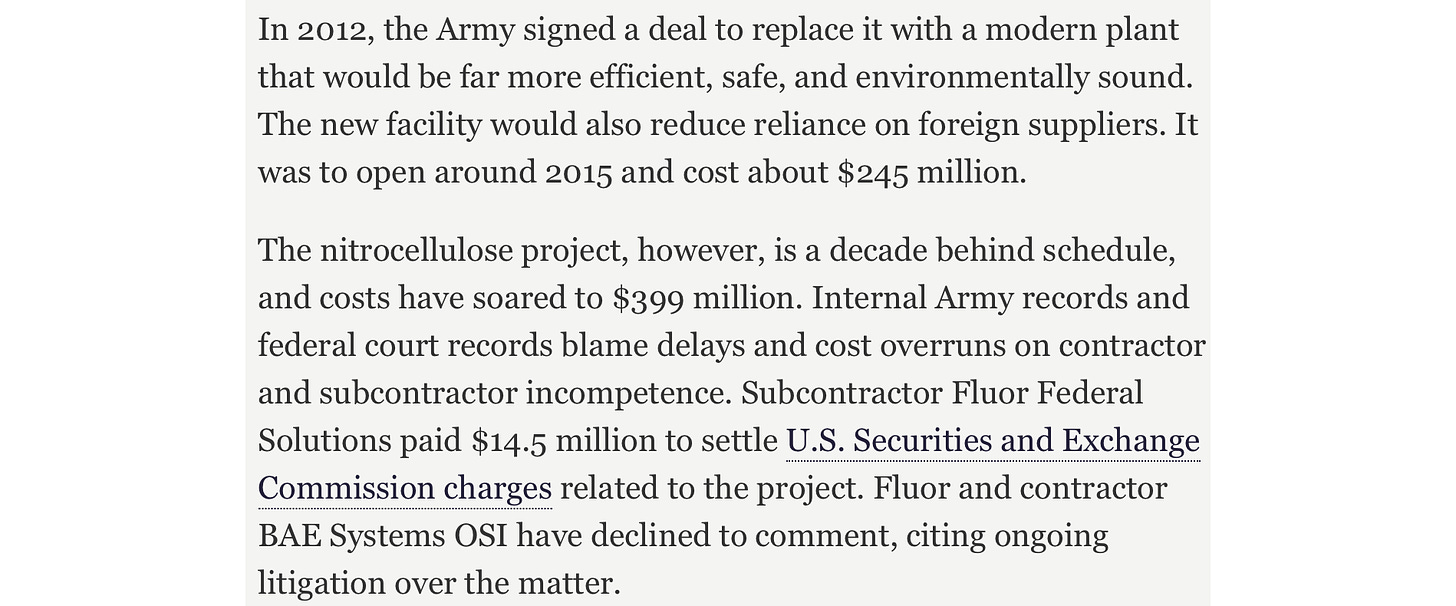
This time, it was Reuters. Last Friday, Reuters ran a long, photo-rich, magazine-style “truth dump” headlined, “Years of U.S., NATO miscalculations left Ukraine massively outgunned.” Now they tell us. It explained, at great length, the real reason that Ukraine is losing the Proxy War, not because of U.S. delays in forking over high-tech wonder weapons and pallets of shrink-wrapped hundred dollar bills, but —and you have to wade through pages of chatter to find it— because of environmentalism.
As you might imagine, explosive chemicals like nitrocellulose and TNT —gunpowder— are very helpful in manufacturing boring, low-tech, and unprofitable battlefield staples like bullets, missiles, and artillery shells. These chemicals help the ordinance ‘explode,’ so to speak, causing distressingly loud noises and generally breaking enemies and their weapons into smaller, much less useful pieces.
But starting in the late 80’s, America’s military acquiesced to activist demands to make “cleaner” weapons for killing our enemies. So they began pulling the plug on most U.S. factories that manufactured explosive chemicals. So did our Western allies:

Reuters explained that only one remaining facility in the United States still makes the stuff that goes ‘boom,’ and that factory is a creaky 1941 museum piece staffed by senior citizens, who are the only ones who remember which buttons to push.

Instead of making the most important part of artillery shells ourselves, the explosives, since they are so toxic, the U.S. military outsourced that environmentally-destructive process mainly to —and I am not making this up— Russia and China.
You can probably already see where there could be some problems with that arrangement.
Since things began heating up in Ukraine in 2014, U.S. generals put aside their makeup mirrors for a minute and focused on the TNT problem. They knew that being unable to build the basics would be a wartime disadvantage. So, knowing conflict in Ukraine was coming, they came up with the terrific idea of making new kinds of high-tech, expensive, profitable, and most important, environmentally friendly explosives:

One struggles to adequately convey the warped irony of focusing on environmental impact when building stuff intended to kill people at scale. But I digress. Anyway, the new high-tech wonder explosives cost billions, didn’t work, and were also toxic. Brilliant.
Apart from our enemies, two other major international plants make military-grade TNT. One is in Poland, now running 24x7 shifts, and the other was in eastern Ukraine. The Russians captured that one about ten seconds after the Proxy War started, proving once again just how far ahead of the game Russian generals are than NATO’s woke warplanners.
Our generals knew all about the TNT problem. But they assumed that if a real war ever started, they could just build whatever they needed, like more TNT factories, scaling up quickly on demand:

Haha! Passive voice alert. It was assumed industry could surge. Mistakes were made! But you know what they say about “assuming.” Assuming means you can shift the blame to somebody else, which is an incredibly attractive feature to career bureaucrats.
The bottom line was that it takes years to build new TNT and artillery plants. And even that assumes you can somehow bypass environmental reviews and federal climate regulations. In fact, in 2012, the army spent half a billion building a brand-new, high-tech TNT plant to replace the 1941 relic, a project that was wildly successful along the lines of the army’s half-billion dollar Gaza pier:

Apparently, that new high-tech TNT plant is now a write-off, probably appearing in a footnote in six-point font somewhere deep in the Army’s financial statement.
Our inability to make our own gunpowder is catching up with us, and mostly harming the Ukrainians. What Ukraine needs most, even more than air defenses, drones, F-16s, or high-tech wonder weapons, are 155mm artillery shells. But our generals are infected with high-tech wonder weapon fever, and scolded the Ukrainians to quit crying about artillery, man up, and figure out a whole new war strategy based on the high-tech weapons that we do have:

Coming up with a revolutionary new military strategy in the middle of a war is a neat idea and everything, but the problem is that just when you get your new, AI-powered, BLASTA-90 mobile drone launch array set up, the nefarious Russians drop an old-fashioned, TNT-packed artillery shell right on top of it, and then you have to scrape up the pieces and start all over again.
For folks in Portland, artillery is important in war because it stops the other army from moving forward. It seems that when you keep lobbing gigantic explosive bombs at an army, it tends to reflexively pull back out of range. But if only one side has those bombs, let’s call that side “Russia,” and the other side, let’s call it “Ukraine,” has none, the “Russkies” can keep pushing the “Ukrainers” back forever and ever, amen.
And that is exactly how Ukraine is losing the Proxy War. The Russians keep pushing the Ukrainians back, by bombing the ever-loving borscht out of them. And since the wonder weapons haven’t helped, there is no realistic solution, except waiting for several years until the West can figure out how to rebuild its scrapped TNT factories without offending environmentalists, who are probably funded by the Russians to begin with, but that’s a different story.
Ukraine does not have years. It might not have months. Its army is vanishing (Reuters: “Ukraine faces a critical and growing shortage of troops compared to Russia.”) Soon, Ukraine won’t have enough soldiers to load artillery shells into cannons, even if it could get the shells, which it can’t.
Thus, NATO is desperately scrambling to plug the TNT dike. The Army toured Reuters around its latest robotic TNT factory in Dallas, which has yet to come online. In its article, Reuters finally told us the truth: we can not make enough weapons to help Ukraine. It was a truth that explains all the weirdest elements of the Proxy War, such as the desperate strategy of launching guided missiles at Russian cities, trying to score a political victory where a tactical victory on the battlefield is clearly impossible.
Reuters’ article hinted at but never grappled with the much bigger problem: How can NATO possibly win any major territorial land war with Russia or China if it mostly depends on those same countries for basics like gunpowder? Biden’s neocons are infected with a Strangelovian sort of wonder-weapon madness that is going to get somebody killed one of these days.

☕️ COLLOSAL ☙ Tuesday, July 23, 2024 ☙ C&C NEWS 🦠
CrowdStrike still striking airlines; experts baffled by hole in the ground; Reuter's truth bombs the Proxy War; bipartisan roasting of Secret Service Director sparks bureaucratic outrage; and more.
I read a few months ago there was also an issue getting Cotton to manufacture Nitrocellulose
Could China strangle Europe’s weapons output with cotton?
In early May, a chemical plant in China’s central Hubei province exploded, killing three people. The culprit was nitrocellulose, a highly flammable material made from cotton. The plant belonged to Hubei Xuefei Chemical, China’s second largest producer of nitrocellulose.
And within days, the accident in Laohekou city had triggered a buying spree of shares in North Chemical Industries – China’s top producer of the material – as rumours over the tightening supply and soaring market demand of the compound ran high.
[clip]
A Chinese explosive detection specialist said nitrocellulose is something that is “quite easy” to produce in the chemical industry, though the flammable and explosive nature means that only a small number of companies are qualified to produce it due to safety concerns.
The circulation of the substance in the market is also under government control, he added.
“When we need it, we would just synthesise it in the laboratory on our own, using sulphuric acid, nitric acid, cotton and a large amount of cooling water and ice,” said the specialist, who asked not to be named due to the sensitivity of the issue.
Therefore, though it is possible that Beijing could withhold products for geopolitical reasons, the real bottleneck for the EU might be itself as ramping up production is possibly something they could do but would rather not.
“Reshoring production of nitrocellulose is more up to European countries’ own will, but it is not the time yet,” Lu, the anti-terrorism adviser, added.
European arms manufacturers have been amassing nitrocellulose and cotton linters, but this is more to replenish their reserves, rather than the goods being in short supply, he added.
“If [the Ukraine] war was to stop in the next couple of weeks, I’m pretty sure the demand for nitrocellulose would go down as well,” Martin said.
Ni Lexiong, a Shanghai-brd military analyst, said firms in Europe were not willing to produce nitrocellulose due to its pollutant and dangerous nature – highlighted by the explosion in Hubei – and had outsourced production to China in the past decades.
“Once a factory is set up and problems arise, their people will protest, so they have to let China produce for them,” Ni said. “And when the war broke out, they started to feel anxious.”
According to the International Trade Centre, China is not the world’s largest exporter of nitrocellulose.
Last edited:
